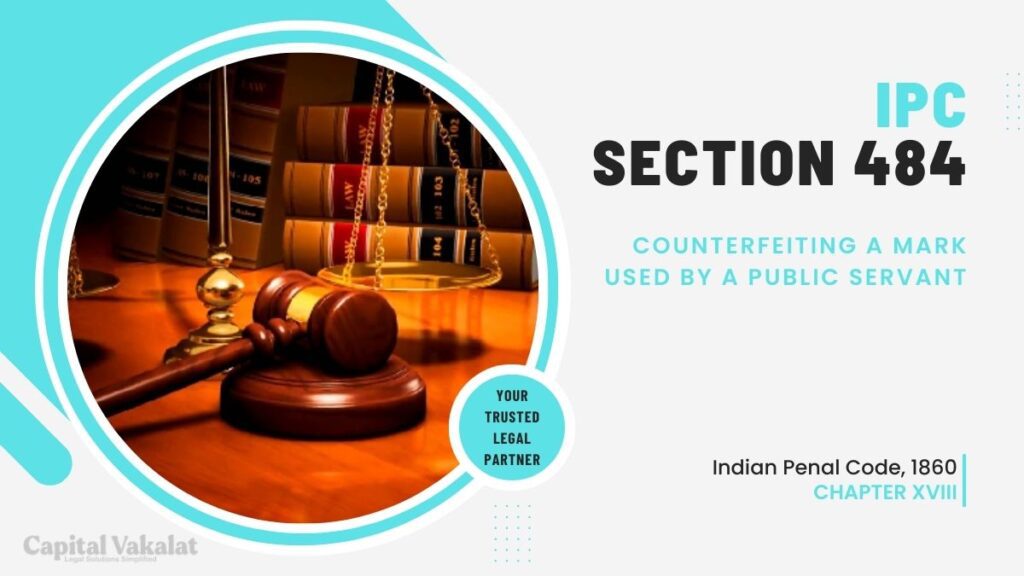Counterfeiting a mark used by a public servant is a grave offense under Section 484 of the Indian Penal Code (IPC). This legal provision is designed to protect the integrity and authority associated with marks used by public servants in the course of their duties. In this article, we will delve into the intricacies of Section 484 IPC, exploring its significance, the impact of counterfeiting on public servants, legal consequences, preventive measures, technological advancements, enforcement challenges, and the need for public awareness.

Counterfeiting a mark used by a public servant is a criminal act that strikes at the heart of the trust and authority bestowed upon individuals serving the public. Section 484 of the IPC specifically addresses this issue, emphasizing the need to safeguard the symbols and marks that distinguish public servants in the performance of their official functions.
Understanding Section 484 IPC
Section 484 of the IPC outlines the offense of counterfeiting a mark used by a public servant. To establish guilt under this provision, certain elements must be present, including intent, knowledge, and the use of a counterfeit mark that is identical or deceptively similar to the original.
Public Servants and Their Marks
Public servants employ various marks in the execution of their duties, ranging from official seals and badges to insignias representing their authority. These marks play a crucial role in ensuring the legitimacy of official documents, actions, and communications.
Impact of Counterfeiting on Public Servants
The counterfeiting of marks used by public servants poses significant risks and challenges. It can lead to confusion, erode public trust, and compromise the effectiveness of official processes. Real-life examples underscore the gravity of these consequences, highlighting instances where forged marks have had far-reaching implications.
Legal Consequences of Violating Section 484
Violating Section 484 IPC carries severe legal consequences. Offenders may face penalties, fines, and imprisonment, depending on the gravity of the offense. Case studies provide insights into the legal outcomes of individuals found guilty of counterfeiting marks used by public servants.
Preventive Measures for Public Servants
Public servants must adopt proactive strategies to safeguard their marks from counterfeiting. Collaboration between law enforcement agencies and public institutions is crucial in developing and implementing effective preventive measures.
Technological Advancements in Mark Protection
Technology plays a pivotal role in preventing mark counterfeiting. Advanced tools, such as digital authentication methods and blockchain technology, offer innovative solutions to protect the integrity of marks used by public servants.
Challenges in Enforcing Section 484 IPC
Despite legal provisions, enforcing Section 484 poses challenges for law enforcement agencies. Obstacles such as the evolving nature of counterfeiting methods and resource constraints must be addressed to enhance the effectiveness of enforcement.
Public Awareness and Education
Creating awareness among the public about the consequences of mark counterfeiting is essential. Educational campaigns and initiatives can help build a sense of responsibility and discourage individuals from engaging in activities that undermine the marks of public servants.
Conclusion
In conclusion, Section 484 IPC plays a vital role in preserving the integrity of marks used by public servants. It is imperative for public servants, law enforcement agencies, and the general public to collectively address the challenges posed by mark counterfeiting. By understanding the legal consequences, adopting preventive measures, leveraging technology, and fostering public awareness, we can contribute to a safer and more trustworthy environment.
Frequently Asked Questions
What role does technology play in preventing mark counterfeiting?
Technology, including digital authentication and blockchain, provides advanced solutions to protect marks from counterfeiting.
How can public awareness help in reducing mark counterfeiting?
Public awareness campaigns educate individuals about the consequences of mark counterfeiting, fostering a sense of responsibility and discouraging illegal activities.
Are there any recent legal developments related to Section 484 IPC?
Stay informed about legal updates, as amendments or new interpretations may impact the application of Section 484 IPC.
Can public servants take personal measures to protect their marks?
Public servants can enhance mark protection by adopting individual measures, such as safeguarding access to official marks and staying informed about emerging technologies for authentication.